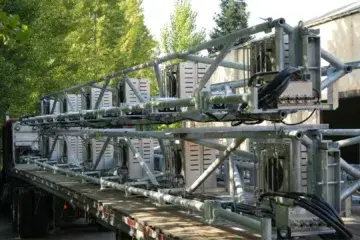Trials of an acoustic fish deterrent (AFD) at Kentucky’s Barkley Lock are underway once more, with results expected early next year.
The BioAcoustic Fish Fence (BAFF) installed by Fish Guidance Systems is designed to deter invasive carp from spreading towards the Great Lakes.
And the system is now back up and running after not one, but two lightning strikes threatened to derail the project.
Lightning strikes twice
As FGS Managing Director David Lambert recently explained to Waterways Journal, the strike in March 2020 was the first time a BAFF system had been disrupted by lightning in over 25 years of installations.
And despite the fact the site had been surrounded by lightning rods from the outset, a second strike came in May.
“We are adding additional surge protection into all the hubs and into all the electronics so that if anything does happen again it will minimise the impact it might have,” David said.
Now, thanks to the efforts of our engineers and partners, we’re delighted to confirm the acoustic deterrent is up and running once more.
Promising preliminary observations
Barkley Lock’s BAFF was originally in operation from December 2019 to March 2020. It was chosen after laboratory tests at the University of Minnesota showed it was 98% effective at blocking the passage of bighead carp and almost 100% successful against common carp.
Now the BAFF is up and running once more, the system will undergo a two-month trial, with analysis of the data expected to take a further two months and results due in the first quarter of 2021.
The process will be aided by tagging of species such as bighead, silver, black and grass carp currently upstream of the dam. They will be relocated downstream and monitored, as they are likely to then attempt to pass the BAFF to return upstream.


